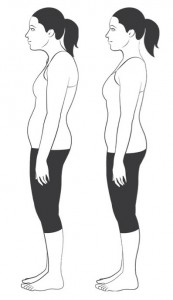Proper standing posture is a problem for many people. Despite our best efforts at good posture, sometimes you just can’t avoid stooping.
When you’re gardening or doing chores that require you to bend over, make sure to keep your knees bent and your back straight.
The same thing goes for when you’re lifting objects: keep your body upright as much as possible since maintaining a natural lumbar curve is a better option than an all-out stoop.
Lifting with a rounded back can put unwanted pressure on your spinal column, potentially injuring your low back.
According to the American Academy of Orthopaedic Surgeons, if you’re going to lift something:
- Position yourself as close to the object as possible so that you’re more stable.
- Keep your feet shoulder-width apart to create a solid base of support.
- Always bend at the knees, tighten your abdominals and lift with your legs.
When you stand for long periods of time, your lumbar curve can become excessive and pain can result (this is called lordosis).
The illustration below (on the left) is a perfect example of a person with a poor standing posture.
You’ve probably seen someone like this before, waiting to place her order at your favorite coffee shop with her head stooped over her phone like the hunchback of Notre Dame.
You’ll notice her shoulders are rounded, causing the upper back muscles to overstretch and tighten up the chest muscles.
This posture can potentially compress the brachial plexus, which is the network of nerves that originate in the neck and feed into the armpit region and down into the arms.
A brachial plexus impingement can lead to a number of problems, from numbness in the hands to thoracic outlet syndrome or carpal tunnel-like symptoms. In this hunched posture, the abs are loose, which gives them an exaggerated lumbar curve.
This kind of slouched posture can trigger low back pain, neck pain, headaches, tendinitis and also lead to worn-out, imbalanced muscles.
It’s like an energy vampire, sucking away any vibrant spirit you possess.
Fear not! I’m here to show you how to combat this slouched posture in six moves.
Here’s the Formula for Proper Standing Posture
Good posture allows your spine to be aligned and balanced.
You can breathe deeply because your lungs and diaphragm have more space to expand and contract.
Not only will you feel more energized and less worn down, but you’ll also look good and be twice as likely to smile. (See illustration above on right)
1. First, stand up with your feet pointing forward or slightly turned inward.
2. Now, squeeze your glutes tightly and rotate your feet inward, so that your big toes slightly turn toward each other.
3. Tighten your thighs, about 50 percent.
4. Slightly tighten your abs, only about 20 percent.
5. Now, roll your shoulders back. This brings your shoulder blades closer together and your chest moves up and forward.
6. Last, turn your hands so that your thumbs are facing forward.
Voilà! You now have proper standing posture.


